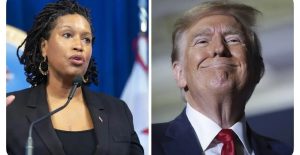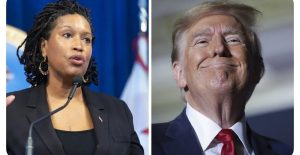1 MINUTE AGO: D.C. MAYOR ISSUES EXECUTIVE ORDER REQUIRING LOCAL POLICE COORDINATION WITH FEDERAL LAW ENFORCEMENT INDEFINITELY.
Contents
Washington, D.C. September 7, 2025 In a move that has sparked both support and controversy, D.C. Mayor Muriel Bowser issued an executive order today requiring the Metropolitan Police Department (MPD) to coordinate indefinitely with federal law enforcement agencies. The order, effective immediately, mandates cooperation to the maximum extent allowable by law within the District and establishes the Safe and Beautiful Emergency Operations Center (SBEOC) to manage this collaboration. This decision comes as an extension of President Donald Trumps recent federal intervention in the capitals public safety operations, raising questions about local autonomy, public safety, and the future of policing in Washington, D.C.

Background: Trumps Federal Takeover and D.C.s Crime Crisis
The executive order follows President Trumps invocation of Section 740 of the District of Columbia Home Rule Act in early August 2025, which placed the MPD under direct federal control for a 30-day period to address what the administration described as a crime emergency in the nations capital. Trumps initiative, dubbed the Safe and Beautiful Task Force, deployed over 2,200 National Guard troops and hundreds of federal agents from agencies such as the FBI, DEA, and U.S. Marshals Service to combat violent crime, clear homeless encampments, and enhance public safety. The White House reported significant results, including over 1,000 arrests, a 20% increase compared to the previous year, and an 87% reduction in carjackings.
Mayor Bowser, a Democrat, initially expressed mixed sentiments about the federal surge. While acknowledging a decline in crimeviolent crime dropped 39% and overall crime fell 14% in the 25 days following the interventionshe voiced concerns about the tactics of Immigration and Customs Enforcement (ICE) agents and the deployment of National Guard troops from other states. Bowser noted that masked ICE agents had caused fear in communities, particularly among immigrants, and described the National Guards presence as inefficient. Despite these reservations, her new executive order signals a willingness to continue federal cooperation beyond the initial 30-day period, which was set to expire on September 10, 2025.
The Executive Order: Key Provisions
The executive order, titled Mayors Order 2025-090, establishes the SBEOC as a centralized hub to coordinate the Districts response to Trumps Safe and Beautiful Task Force. The SBEOC will focus on public safety, justice, homelessness, beautification, and economic resilience. It mandates that federal law enforcement officers adhere to community policing practices, such as avoiding masks, clearly identifying their agencies, and providing identification during arrests to maintain public trust.

Reactions: Support and Criticism
The executive order has elicited polarized reactions. Supporters, including White House Press Secretary Karoline Leavitt, praised Bowsers decision as a step toward making D.C. the safest city in the country. Leavitt emphasized that the collaboration has delivered measurable results, urging other Democratic mayors to follow Bowsers example. The D.C. police union called the order a vital step toward enhancing public safety but cautioned that it does not address underlying issues like staffing shortages and low morale within the MPD.
Critics, however, view the order as a capitulation to federal overreach. The DC Against Trump Coalition (DCAT) organized a protest on September 3, 2025, outside the Wilson Building, chanting slogans like We dont need collaboration, end this racist occupation! Protesters, including members of the DC Alliance Against Racist and Political Repression, argue that the federal presence disproportionately targets Black and immigrant communities, undermining public safety rather than enhancing it. D.C. Councilmember Zachary Parker echoed these concerns, stating, Washingtonians want decisions guided by our community values, not federal overreach.
Legal experts have also raised alarms. The Home Rule Act allows presidential control of the MPD for up to 30 days during emergencies, but Bowsers order extends federal influence indefinitely, potentially bypassing congressional approval required for longer-term federalization. A recent federal court ruling found that Trumps similar deployment of National Guard troops in Los Angeles violated the Posse Comitatus Act, which restricts military involvement in civilian law enforcement, casting doubt on the legal foundation of the D.C. operation.

Bowsers order navigates a delicate balance between leveraging federal resources and preserving local control. By establishing the SBEOC, the mayor aims to create a framework for transitioning away from emergency federal oversight while maintaining coordination with federal agencies. However, the indefinite nature of the order has fueled fears that D.C. could become a testing ground for broader federal interventions in urban policing, as Trump has suggested expanding similar measures to cities like Chicago and Baltimore.
Crime data supports the effectiveness of the federal surge, with a 22% drop in violent crime reported in the week following Trumps intervention. Yet, critics argue that these gains come at the cost of community trust and local autonomy. The increased presence of federal agents, particularly ICE, has led to reports of aggressive detentions in immigrant communities, prompting Bowser to reiterate her commitment to transparent policing practices.
Looking Ahead
As D.C. approaches the September 10 deadline for Trumps emergency declaration, Bowsers executive order ensures that federal-local collaboration will continue, potentially averting a confrontation over the MPDs control. The SBEOCs role in managing this partnership will be critical in balancing federal support with local priorities. However, the orders open-ended nature raises questions about how long D.C. residents will tolerate a sustained federal presence and whether this model will influence policing strategies nationwide.
For now, Bowsers decision reflects a pragmatic approach to a complex issue, acknowledging the benefits of federal assistance while attempting to safeguard community trust. As the nations capital navigates this unprecedented partnership, the debate over safety, autonomy, and federal authority is far from over.
Sources: The Washington Post, Breitbart, TIME, Newsweek, American Almanac, Fight Back! News, The White House, WTOP News
Leave a Reply